
DIY Driveway Edging Ideas to Boost Curb Appeal on Any Budget
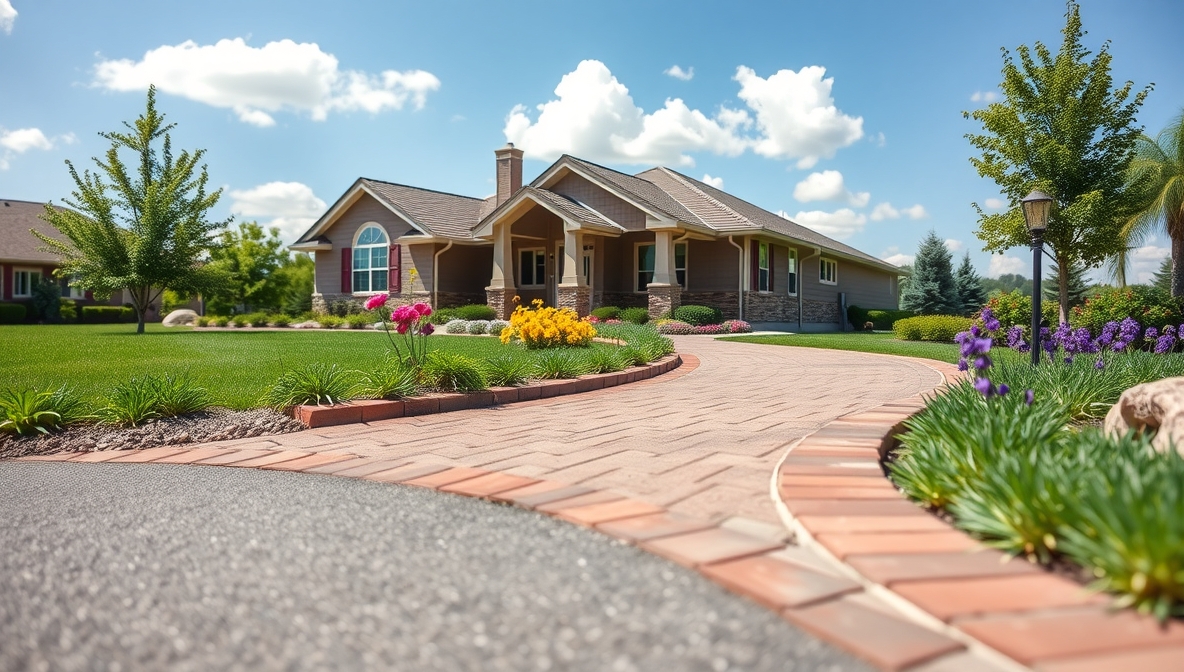
A driveway often sets the first impression for a home, yet many homeowners overlook its potential. Edging not only frames the path beautifully but also prevents gravel or soil from spilling over, making the whole space look tidy and intentional. From sleek modern lines to rustic charm, the right border can tie your landscaping together while adding personality.
Brick, stone, wood, or even upcycled materials can become stylish borders that match your home’s character. Each choice brings its own texture, color, and durability, so exploring different options can help match your design vision. Practical benefits come along with the beauty — a solid edge can help reduce erosion, guide rainwater, and keep plant beds neat.
For a quick weekend project, repurposed pavers or stacked stones can give the driveway a polished finish without professional help. More elaborate designs with poured concrete or custom-cut blocks make a lasting upgrade that feels high-end.
With a bit of planning, edging can turn a plain driveway into a standout feature. Small details often make the biggest impact, and in the case of driveway borders, that impact starts right at the curb.
Table of Contents
ToggleDIY Driveway Edging Ideas
Driveway edging adds beauty and function to your home. It keeps gravel or paving in place. It stops grass from spreading. It also creates a clean border that lifts the look of your driveway.
This guide shares 10 easy and affordable ideas you can try at home. Each idea comes with a list of materials and simple steps. No need for fancy tools or advanced skills. Just a little time, effort, and creativity.
1. Brick Border Edging
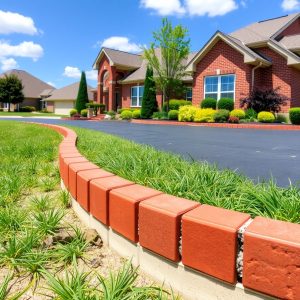
A classic choice that suits almost any style. Bricks bring a neat, timeless look to your driveway.
Materials
-
Standard red bricks
-
Sand
-
String line
-
Shovel
-
Rubber mallet
Steps
-
Mark the edge of your driveway with a string line.
-
Dig a shallow trench along the line. The trench should match the width of your bricks.
-
Add a layer of sand at the bottom. Level it with a trowel.
-
Place the bricks in the trench, side by side. Keep them tight together.
-
Tap each brick gently with the rubber mallet to secure it.
-
Fill gaps with sand and sweep off extra sand.
2. Concrete Curb Edging
Strong and long-lasting. Concrete curbs create a clean line and help control soil erosion.
Materials
-
Ready-mix concrete
-
Wooden stakes
-
String line
-
Shovel
-
Trowel
-
Mold or form boards
Steps
-
Set wooden stakes along the driveway edge.
-
Tie the string to guide the curb line.
-
Dig a trench for the curb mold.
-
Place the mold or boards to hold the concrete.
-
Mix and pour the concrete into the mold.
-
Smooth the surface with a trowel.
-
Let it dry for at least 48 hours before removing the mold.
3. Stone Paver Edging

Natural stone pavers bring a rustic and rich feel. Each stone adds character.
Materials
-
Flat stone pavers
-
Sand
-
Shovel
-
Level
-
Rubber mallet
Steps
-
Lay out the stones on the ground to plan the look.
-
Dig a trench along the driveway edge.
-
Add a thin layer of sand.
-
Set each stone into the trench.
-
Check with a level to keep them even.
-
Tap lightly with the mallet.
-
Fill spaces between stones with sand.
4. Steel Landscape Edging
Steel edging offers a modern, clean look. It is thin yet strong and keeps materials in place.
Materials
-
Steel edging strips
-
Stakes (often included)
-
Mallet
-
Shovel
Steps
-
Measure and cut the steel strips to fit your driveway.
-
Push the edging into the soil along the edge.
-
Use stakes to secure the strips in place.
-
Tap the top edge with a mallet for a smooth finish.
5. Wooden Timber Edging
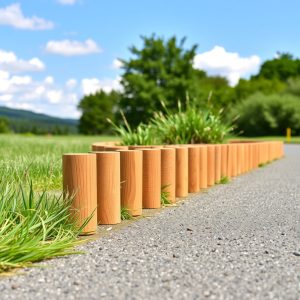
Wood adds warmth and blends with nature. Treated timber lasts longer outdoors.
Materials
-
Treated wood timbers
-
Galvanized spikes or screws
-
Drill
-
Shovel
-
Level
Steps
-
Measure and cut the timbers.
-
Dig a trench the size of the timber’s thickness.
-
Place the timber in the trench.
-
Check the level and adjust if needed.
-
Secure with spikes or screws.
6. Cobblestone Edging
Cobblestones are strong and charming. They give a driveway a traditional look.
Materials
-
Cobblestones
-
Sand
-
Shovel
-
Mallet
-
String line
Steps
-
Mark the border with a string.
-
Dig a trench to fit the stones.
-
Add a sand base.
-
Place each cobblestone in the trench.
-
Tap gently with a mallet.
-
Fill joints with sand.
7. Gravel Strip Edging
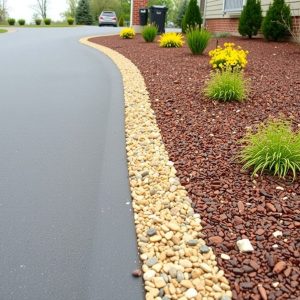
A gravel strip acts as a drainage zone. It works well for water control and adds a neat line.
Materials
-
Gravel
-
Landscape fabric
-
Shovel
-
Rake
Steps
-
Dig a shallow trench along the driveway.
-
Lay landscape fabric to block weeds.
-
Pour gravel over the fabric.
-
Rake to spread it evenly.
8. Plant Border Edging
A living edge made of plants softens the driveway and adds color.
Materials
-
Low-growing plants (like lavender, boxwood, or ornamental grasses)
-
Spade
-
Compost or soil mix
Steps
-
Mark the planting line.
-
Dig holes for each plant, spaced evenly.
-
Add compost to each hole.
-
Place plants in the holes and cover with soil.
-
Water well.
9. Recycled Material Edging
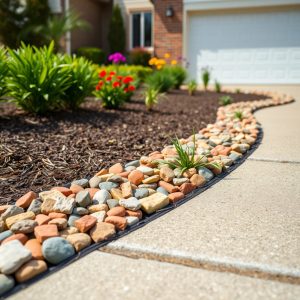
Old roof tiles, bottles, or broken concrete pieces can create a unique edge.
Materials
-
Chosen recycled items
-
Shovel
-
Sand or soil
Steps
-
Collect enough materials to cover the edge.
-
Dig a shallow trench.
-
Stand the materials upright in the trench.
-
Backfill with soil or sand to keep them firm.
10. Decorative Rock Edging
Large decorative rocks add a bold, natural border. They also prevent soil from washing away.
Materials
-
Large decorative rocks
-
Shovel
-
Landscape fabric (optional)
Steps
-
Plan the layout of the rocks.
-
Dig a shallow base for each rock.
-
Place the rocks along the driveway edge.
-
Adjust positions for a balanced look.
FAQs
1. Why add edging to a driveway?
Edging keeps the driveway material in place. It also makes the driveway look neat and finished.
2. What is the cheapest edging option?
Gravel or recycled material edging often costs the least.
3. How long does driveway edging last?
It depends on the material. Concrete or stone can last decades. Wood may last several years with treatment.
4. Do I need special tools for edging?
Most projects need only basic tools like a shovel, level, and mallet.
5. Can edging help with water drainage?
Yes. Gravel strips or certain plant borders can improve drainage.
Conclusion
Driveway edging improves both looks and function. It prevents spreading, controls erosion, and gives a tidy finish. From bricks to plants, there are many styles to fit your budget and taste. Simple tools and a weekend of work can make a big change to your home’s curb appeal.
